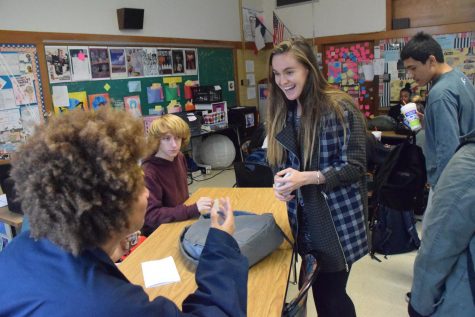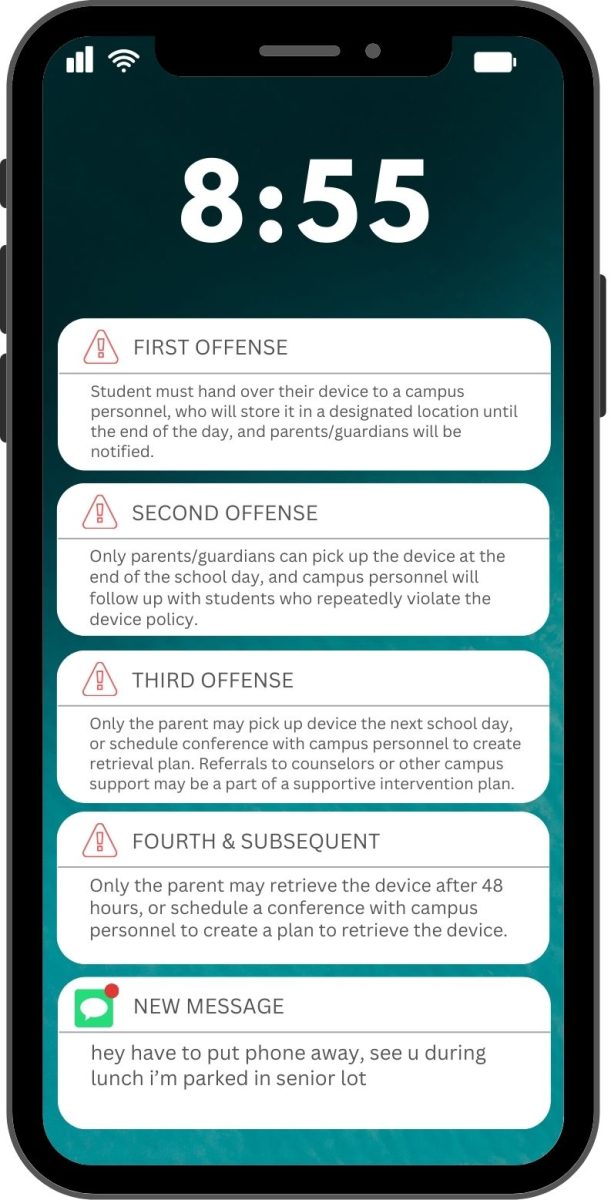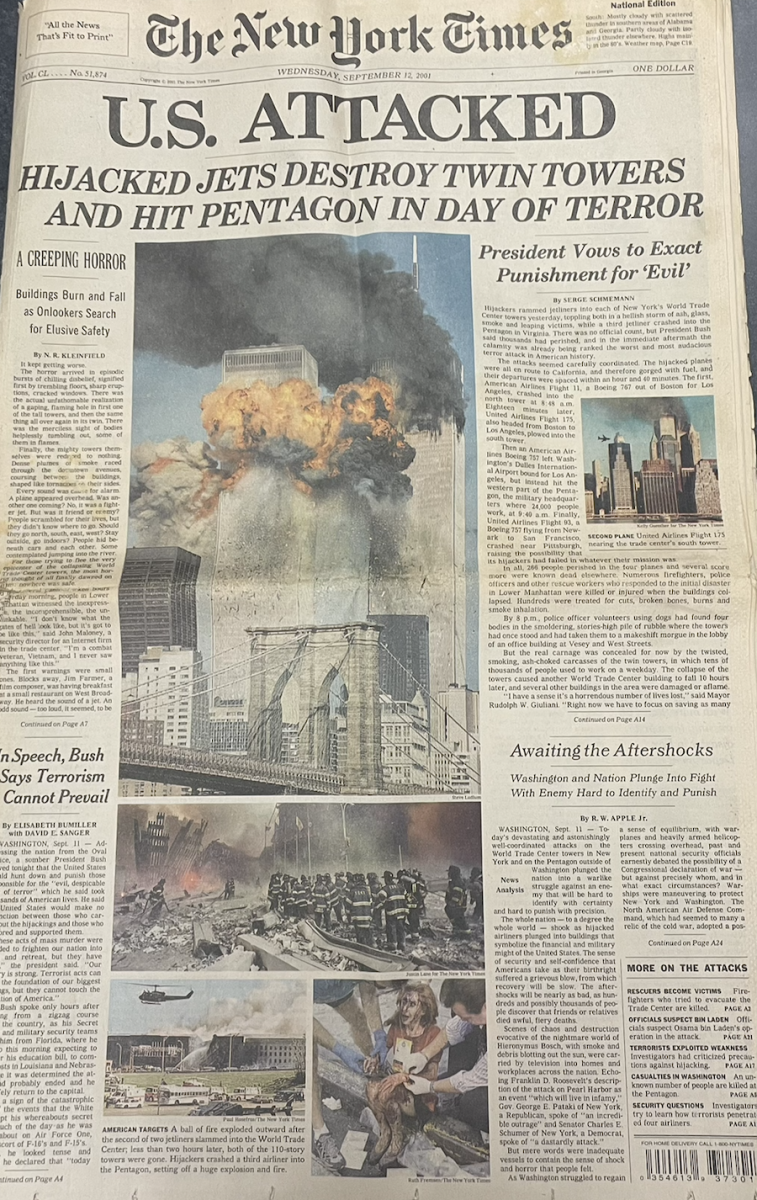
“Is McCallum woke?” asked a poster in McCallum’s main hallway. It urged students in November to submit “the questions about race they were too afraid to ask”.
This poster, with its provocative questions, was the work of Lucy Griswold’s ethnic studies class. In its pilot year at AISD as a social studies elective. The course examines history and politics from the perspective of ethnic minorities.
“Young people right now are talking about race,” Griswold said. “It might be on Twitter and mostly memes, but still, people are talking about it.”
After reading a study published by Stanford that observed that students who took an ethnic studies course had better grades, attendance, and attitudes towards education, the AISD board of trustees made an official request to create an ethnic studies curriculum. Jessica Jolliffe, AISD’s social studies supervisor, brought together a team of teachers to design such a program, now being piloted at seven high schools.
“Attendance is really important,” Jolliffe said. “You want students to be invested in school, you want students to be making good grades, to feel like they have a connection with what they’re learning in class … that they also feel that they belong in school and that people are discussing issues, history, experiences that reflect their own lives.”
Joliffe said while it is too early to conclude that ethnic studies pilot program has improved student attitudes toward and attendance at school, the early reports are extremely promising.
“Students do feel a sense of connectedness and belonging, and they see themselves reflected in the curriculum as a result of that culturally-relevant pedagogy and resources that the students get in the class,” Joliffe said.
As well as working with the district team, Griswold also helped to design a course as a graduate student at the University of Texas that Austin ISD later on ended up using as inspiration for its curriculum.
“We have six themes that structure the semester,” Griswold said. “The first theme is the idea that race is biologically false, but socially real… The idea of race is quite a new idea; it started in the 17th century and changes historically as society creates it. The last theme we discuss, the sixth, is something called intersectionality. … We talk about how we have to complicate just thinking about ethnicity and think about other different structures of power in society. The course has a contemporary focus, so we look a lot at current racial politics, current political issues, current events, just start from there and then go back historically and try to explain how we evolved to the current moment.”
Though Austin ISD has been able to develop its own course, there has been significant discourse at the statewide level on the topic of an ethnic studies course. The state BOE rejected creating a curriculum for such a class in 2014, but requested that textbooks be submitted on the topic in each subsequent school year.
There is dissent among the members of the state board over whether a statewide ethnic studies course should even exist in the first place, as districts are free to create their own curriculum. Additionally, the board declined to adopted either of two proposed Mexican-American Studies textbooks. According to a board-sponsored study published on its website, the first proposed book contained such controversial statements as, “stereotypically, Mexicans were viewed as lazy compared to European and American workers” and those in the Chicano rights movement of the 1970s were attempting to “destroy this society.”
The second book was rejected once a committee ruled that it was too riddled with factual inconsistencies. Last November, they voted in favor of a memoir about the Holocaust, their first approved ethnic studies textbook.
Considering that Texas serves more than 5 million students in its public schools, it has significant clout in the textbook industry; books they approve are often adopted by other states. Of that 5 million, 52 percent identify as Hispanic, 29 percent as white, 13 percent as African-American, and 4 percent as Asian, according to the Texas Education Agency.
Debbie Ratcliffe, the director of media relations for the State Board of Education, said that the board intends to discuss the creation of an official ethnic studies course at its meeting in late January, which could be implemented as early as 2020.
The public affairs specialist for the Texas State Teachers Association, Clay Robison, says that it is imperative for the board to create a statewide course for the sake of less wealthy school districts.
“Local school boards can adopt their own materials if they want to, but a lot of school districts don’t have the resources to do that, which is why it should be done on the statewide level, because the books that that state board adopts can be used at the local level,” Robison said. “It’s important that the state board continues to address this issue and come up with a curriculum– a fair, balanced curriculum that accurately reflects the Mexican-American contributions to Texas history and culture– and that a book that includes the points and standards in the curriculum be published that can be adopted and recommended for use in all the schools. That’s a process that will a little time, unfortunately, but it’s a process that should’ve already been done.”
Robison urges parents and educators to convince the State Board of Education and the Texas Education Agency to continue working on developing a statewide ethnic studies curriculum.
“A majority of the students at Texas public schools are Hispanic, and they need to be able to read textbooks and other instructional materials that more accurately reflect the contributions their ancestors made to their state’s history and culture,” he said. “They should be able to read books, they should be able to engage in classroom discussion, instruction, and activities about that. It’s the only right thing to do.”
The students in AISD’s course use a multicultural history book, “A Different Mirror”, written by Ronald Tataki, but Griswold says that the class is not structured in any way around one book or resource.
“Textbooks can be nice because they provide a structure and they provide a backbone, but teachers at this schools are given the freedom to bring in a lot of sources,” Griswold said. “I think when you’re talking about something as politically charged and controversial as race, you need as many perspectives as possible. Even with a textbook that’s written ‘objectively,’ it’s still important to bring in lots and lots of ideological positions.”
Jolliffe agrees; she says that the loose requirements have given teachers a much-needed amount of flexibility under the requirements.
“We want to have a unit on civil rights, we want to have a unit on legal issues, we want to have a unit of economic policies, so teachers have a basic frame for what they should be teaching, but then for the specific case-studies, in terms of content they want to include, they can really tailor that to meet the needs of students that are in their classrooms,” she said. “So if you’re in a class that has a lot of Asian-American students, you might want to focus more on issues that most directly affect Asian-Americans; if you’re in a class with primarily Latino students, you might want to focus on issues that impact Latino students.”
One unique project in Griswold’s class featured the posters that appeared in McCallum’s halls.The students, who also designed a Snapchat filter requesting questions from the student body, collected more than 400 questions, which they will later answer on a website as their final project for the course.
“One of the questions was, ‘’Is Vicky black?’ She’s this Instagram celebrity who most people would read as a white girl, and she, in other ways, like culturally, appears black,” Griswold said. “Even though this question is really simple and something that most students know about, it actually requires you to answer the question, ‘What is race?’ Is Vicky black? Well, she says she has black ancestry, does that make her black? Does being culturally black make you black? Even though some of the questions seem really simple at first, they actually require having a pretty sophisticated understanding of race and ethnicity. So again, I think it’s important to start with how students are engaging with their questions in these everyday lives and then go deeper and think about how these connect to issues.”
Katie Carrasco, the social studies department chair, said that the main challenge has been recruiting students for the program, but those who have been in it have given her great feedback.
“It’s a benefit to the school, to the students,” Carrasco said. “I think it’s allowing for a structured platform for conversations to take place in a really constructive way; I think a lot of students, and adults for that matter, are wanting to have conversations but don’t know how to go about it, and so it’s a really exploratory way to look at the issues.”
Sophomore Charlotte Evelyn agrees; she’s been a part of Griswold’s first ethnic studies course, and she gives nothing but praise for the discussions she’s been a part of during the class.
“It’s a really open and safe space to learn about potentially sensitive topics and really gives everyone involved a new perspective on the world,” she said. “Also, Ms. Griswold is honest and helpful every single day. We also have focused heavily on intersectionality, which has brought many issues to light that I didn’t even realize were around me. Issues of inequality or injustice in my own community, city, school are so real, and looking into their causes and effects has made me a more well rounded person.”
According the Jolliffe, the class will be taught at every AISD high school next year, and in the future they want to work on increasing enrollment and potentially even developing an ethnic studies course for middle school campuses. She stresses how successful the beginning of the program has been, and expressed hope for its growth in the future.
“The most common comment from those enrolled in the course this semester has been, ‘I can’t believe I haven’t already learned this, and I can’t believe no one’s ever talked to me about this, and I’m so happy I’m learning this information now,’” she said. “They felt like they were learning material that was really important, that was relevant to them, that teachers and students were discussing real issues.”







